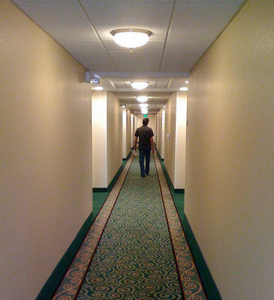Creativity – much like intelligence – is a highly-valued trait. It is also – much like intelligence – a term that encompasses multiple abilities applied across a broad number of domains, which can result in some confusion over precisely what one means when the word is used. Since I wanted to think a bit about creativity today, a good starting point for this discussion would be to clarify what creativity refers to in terms of function and form. Being clear about these issues can help us avoid getting mired in topics related to creativity – like intelligence – but which are not creativity themselves. There’s nothing quite like definitional confusion when it comes to stagnating discussions; just ask gender.
These are all bathrooms now, and there still aren’t enough kinds
In terms of a good starting definition for thinking about creativity, I think we are lucky enough to have one available to us. Paraphrasing a bit from Plucker, Beghetto, and Dow (2004), creativity generally refers to the creation of something novel that manages to do something useful or appropriate. The former point is generally accepted in common usage: products or people that are viewed as creative are or do something that hasn’t been done quite that way before. Something new is being created (hence the term), rather than something being repeated or copied. The less-appreciated – but equally important – facet of the definition is the latter portion. There are a great many ways of creating something new without it being creative. You might, for instance, write a bunch of nouns on pieces of paper, mix them in a bag, then pull two at random and create a new product with them. Say you pulled out a piece that said “clock” and another that said “fish” and so designed a clock with a dead fish nailed to the middle of it. While that design would be novel – at least I haven’t seen many clocks with attached fish – it wouldn’t be appropriate or useful in most senses of the word. There’s thus a difference between creative and just being different, or even random. A quick examination of the lyrics to any Mars Volta song should highlight the importance of appropriateness when considering whether novelty is creative or just nonsense. Anyone can string words together in new ways, but that does not always (or even usually) make for a creative song.
Which brings me to another important point about problems and their solutions more generally: there is no such thing as a general-purpose problem and, accordingly, no such thing a general-purpose solution. To place that into a quick example, if I asked you to design me a tool that “does useful things,” you would likely find that request a bit underspecified. What kind of useful things should it do? This is an important question to answer because tools that are designed to do one task well often do others poorly, if at all. A hammer might be good at driving a nail into wood, less good at applying paint to a wall, worse still at holding water, and entirely incapable of transporting you from point A to B. The shape of a problem determines the shape of the solution, and as all problems have different shapes, so too must each solution.
There are several implications that flow from this idea as it pertains to creativity. The first is that the difference between novelty and creativity can be more readily understood. If I told you I wanted a device to hold water, there are an infinite number of possible devices you could give me that don’t currently exist. However, very few of that infinite set would do the job well (a hammer or sieve would not) and, of those that do accomplish the task, fewer still would be an improvement on existing solutions. This is why “novel” alone does not translate into “creative.”
As seen on TV, since no store would ever stock it
Yet another implication is that – just like humans (or any other species I’m aware of) don’t appear to possess general-purpose learning mechanisms, equally capable of learning anything – so too should we expect that creativity is not any singular mechanism within the mind that gets applied equally well to any problem. Those who are considered creative with respect to painting may not be expected to evidence that same degree of creativity when it comes to math or biology. It’s not likely that there’s a way to make people more creative across every domain they might encounter. After all, if creativity refers to the generation of more efficient and appropriate solutions to problems, asking that someone become more creative in general is like asking that they become better at effectively solving all types of problems or making connections between all areas of their brains. In keeping with the tool example from above, it would also be like asking that your water-holding device get better at solving all problems related to holding liquid (small and large quantities or varying types for varying lengths, etc), which doesn’t work well in practice; if it did, we wouldn’t need oil drums and cooking pots and measuring cups. We could just use one device for all of those tasks. Good luck using a 40-gallon drum to measure out a quarter cup of water effectively, though.
This expectation has been demonstrated empirically as well. Baer (1996) examined what effects training poetry-relevant creativity skills would have both writing poetry and short stories; an ostensibly-related domain. In this case, approximately 75 students were trained up on divergent-thinking skills relevant to poetry including thinking of words that sound the same as a target, have the same sound, work as a metaphor, or inventing words that are suggestive of other things. Another 75 students did not receive this training to serve as a control group. All the students then wrote poetry and short stories that would be evaluated by independent judges for creativity on a 1 to 5 scale. As it turned out, the poems written by the trained students did end up more creative (3 vs 2.2), yielding a gain of about 0.8 points. By contrast, the short stories in the trained group saw a substantially smaller gain of 0.3 points (2.8 v 2.5). Creativity training did not appear to have an equivalent effect across domains, even though the domains were, in many respects, closely related.
The final implication I wanted to cover right now when it comes to creativity concerns the purpose of solutions in the first place. We seek solutions to problems, in large part, because solutions are time savers. Once you have learned how to complete a task, you don’t need to relearn how to complete it each time you attempt it. Once I learned how to commute to work, I don’t need to figure out how to get there every day, which saves me time. Chefs working in kitchens don’t need to relearn how to make dishes (or even what dishes they will be making) each and every time they come into work, allowing them to complete their tasks with greater ease in shorter amounts of time. By contrast, creativity can be a time-consuming process, where new candidate solutions need to be developed and tested against existing alternatives, then learned and mastered. In other words, creativity is costly both in terms of the time and energy it takes to develop something new, but also costly in the sense that all the time you spend creating is time spent not applying existing solutions to a problem. The probability of your creative endeavors paying off at all in terms of improving outputs, as well as the degree to which they improve upon existing alternatives, needs to be weighed against the time it takes to develop them.
Thanks for all your hard work and effort. Next!
But what if your creative endeavors are successful? Well, first of all, good for you if they are. Achieving that much is no easy task. But assuming they are successful, you now have a new, even-more efficient solution to a problem you were facing. What are you going to do now? Well, you could continue your creative search for an additional solution that’s even better than the one you came up with, or you could apply your new solution to the problem. Remember: solutions are time savers. If you spend all your time innovating and none of it actually applying what you came up with, then you haven’t really saved time. In fact, if you aren’t going to then apply that solution, searching for it seems rather pointless. The great irony here, then, is that an end goal of creativity is effectively to not have to be creative anymore, at least with respect to that problem.
The more empirical end of this suggestion is represented by the finding that creativity appears to decrease with education, at least among engineering undergraduate students. Sola et al (2017) examined a sample of approximately 60 introductory and senior engineering college students. Creativity was assessed through a thinking-drawing procedure, where participants were presented with an incomplete picture and asked to complete it in any manner they wished. These drawings were subsequently assessed across 15 factors, ultimately finding higher creativity scores among the freshmen, on average, in several of the domains.
Nothing quite like the tried and true
To be clear, then, some people will generally be more creative than others, just like some people will generally be more intelligent than others. In that sense, you could consider some people creative. That does not mean their creativity will extend to all domains of life, however, or even that their creativity will extend throughout the same domains across their life. When you have a solution to a problem, the need to seek out a new solution is relatively lower, and so creativity should decline.
An implication of this framework would seem to be that if you want to keep creative output high, you need to constantly be facing problems that are perceived to be notably different from those already encountered (and the solutions to those problems need to be meaningful to find. People likely won’t be too motivated to be creative if finding a new solution will only yield minimal benefits). That said, there is also a risk in making a constant stream of problems seem novel: it suggests that the creative solutions you develop to a problem are not liable to serve you well in the future, as the problems you will face tomorrow are not the same ones you are facing today. If the solutions are not perceived to be useful in the future, creative efforts may be scaled back accordingly. Striking that balance between novelty and predictability may prove key in determining subsequent creative efforts.
References: Baer, J. (1996). The effect of task-specific divergent thinking training. The Journal of Creative Behavior, 30, 183-187.
Sola, E., Hoekstra, R., Fiore, S., & McCauley, P. (2017). An investigation of the state of creativity and critical thinking in engineering undergraduates. Creative Education, 8, 1495-1522.




